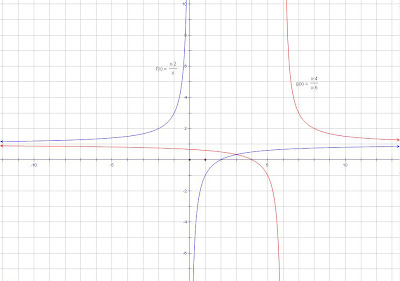




HAVE A GOOD HALLOWEEN EVERYONE!
Here we will use mathematics to explore, describe and build connections. Together we learn.
 Graphically:
Graphically:  The red line represents f(x) = (x-4) / (x-6)
The red line represents f(x) = (x-4) / (x-6) How to solve rational inequalities:
How to solve rational inequalities: 1) Bring all values to one side, resulting on one side equaling to 0
1) Bring all values to one side, resulting on one side equaling to 0 3) Find the vertical asymptotes, zeros, and restrictions
3) Find the vertical asymptotes, zeros, and restrictions 5) Plot the vertical asymptote, zeroes (These are the factors the can affect the sign of the function)
5) Plot the vertical asymptote, zeroes (These are the factors the can affect the sign of the function) 6) Use test points to determine the sign of the expression in each interval.
6) Use test points to determine the sign of the expression in each interval. 7) State the solution
7) State the solution

1----->1
2-----> 1/2
3-----> 1/3
As the graph of the quadratic moves UP the reciprocal function moves DOWN. As the quadratic function INCREASES our reciprocal DECREASES.
1/2-----> 2
1/3-----> 3
As you can see, the same goes for fractions and negative x-values of our quadratic function and the x-values of the reciprocal quadratic function. As the x-values of the quadratic function DECREASE, the values of the reciprocal function INCREASE.
****For Ms. Burchat’s period 3/4 class:****
If you still don’t see the importance of conceptual understanding, recall her university horror story and be scared into caring about conceptual understanding! And another lifelong rule? Don’t let anyone call you slave.... Or esclave, servus, or esclavo. Or even sklave or abed for that matter.
Don’t ask me how I found it. =)
 Rational functions are in the form f(x)= P(x)/Q(x) where P(x) and Q(x) are polynomial functions and Q(x) is degree 1 or higher. The simplest rational function is f(x)= 1/x.
Rational functions are in the form f(x)= P(x)/Q(x) where P(x) and Q(x) are polynomial functions and Q(x) is degree 1 or higher. The simplest rational function is f(x)= 1/x.


Inequality deals with a range of values, rather than an exact number, so it is necessary to replace the equal sign in an equation with its supposed inequality (either >, <, >, or <).
For example, Solve for the following inequality:
(x + 10) (2x – 9) > 0

 We must also notice that the middle interval must (graphically) be larger than -10, yet smaller than 9/2, so, respectively, the inequality is represented by -10 <>
We must also notice that the middle interval must (graphically) be larger than -10, yet smaller than 9/2, so, respectively, the inequality is represented by -10 <>

| Interval Factor | x < -10 | -10 | x > 9/2 |
| (x +10) | ( - ) | ( + ) | ( + ) |
| (2x – 9) | ( - ) | ( - ) | ( + ) |
| f(x) | ( + ) | ( - ) | ( + ) |
Note: Page 8 of our textbooks summarizes all possible intervals
Therefore, the solution is XE(-∞, -10] U[9/2, ∞)